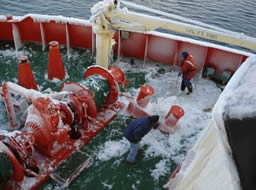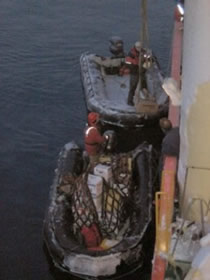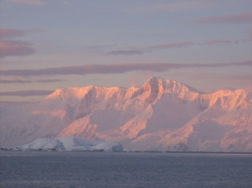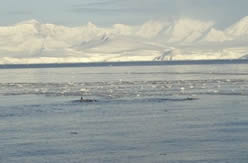
 |
| Academic Departments | Student Services | Alumni | Research | Outreach | Diversity |
| 1 | 2 | 3 | 4 | 5 | 6 | |
| 7 | 8 | 9 | 10 | 11 | 12 | 13 |
| 14 | 15 | 16 | 17 | 18 | 19 | 20 |
| 21 | 22 | 23 | 24 | 25 | 26 | 27 |
| 28 | 29 | 30 | 31 |
| 1 | 2 | 3 | ||||
| 4 | 5 | 6 | 7 | 8 | 9 | 10 |
| 11 | 12 | 13 | 14 | 15 | 16 | 17 |
| 18 | 19 | 20 | 21 | 22 | 23 | 24 |
| 25 | 26 | 27 | 28 | 29 | 30 |
Daily Journals
May 21, 2006
Ay, Caramba!! Woke up (the other side of having been asleep!) this morning to calm waters and land! It’s the most beautiful landscape you’ll ever see. Looming, large, oh, so large. Toto, hold on to those ruby slippers for now, I’m stayin’!! The decks are a-buzz with activity. First and earliest, the deck hands
were out with large rubber mallets, ‘hammering’ the ice off the decks,
rails, and necessary equipment (including the zodiac). Decks are open again, the water is like glass, everyone is out, and the Camera is King. We are in Dallmann Bay near the Melchior Islands, all named for Greek letters. One is round-topped, another jagged, another appears mostly made of snow and ice with huge crevasses making it look like it’s about to break apart. It seems more like a harbor because of the overlapping of islandscape. Grey, then gray-blue, then ‘sky blue pink’ (Pam) and pink and finally white. The sun is fully up around 10:00, and at its peak is not higher than the island mountain peaks themselves. We’ll enjoy the sun’s light until maybe 3:30pm and then the moon and its accompanying planet (Venus?) will reign over the mountained horizon again. This bay is flat calm, and the water is pockmarked with small icebergs. We
can see by its gray hue that the water surface is freezing closer to
shore. Izzy Williams spotted some “mammal activity!!” in the distance,
near that gray frozen zone. We were able to identify a pod of killer
whales, orcas, feeding about 1.5 miles away! When the philanthropic
exercise was over, Larry Brissette (3rd Mate) maneuvered the ship nearer to Getting to Know You
Back to the Science Catch of the Day
So, don't hesitate to email questions to us at outreach@lmg.usap.gov
|
Longitude/Latitude: S64° 20.415’ W62° 59.829’ Temperature: Wind: Light S about 5kn
Menu: Pepper steak, fish, mixed corn vegs, salad; Vegetable quiche,
Photos:
Abandoned Argentine station in
Dallmann Bay. [Photo by Steve Rupp]
Camera clique E. Bailey, P. Polloni, R. Waller, W. Jaeckle, S. Balser Andy Mahon provided this shot of the orcas in Dallmann Bay. Pam Polloni and Jen Putland [Photo by E. Bailey] Iceberg with ‘pond’ in front right corner. [Photo by E. Bailey] |
- Alabama Agricultural Experiment Station
- Alabama Cooperative Extension System
- Auburn Online Community
- Bookstore
- Center for Diversity
- Crisis/Incident Assistance
- Diversity and Multicultural Affairs
- Financial Aid
- Hotel and Conference Center
- Jule Collins Smith Museum of Fine Art
- Medical Clinic
- Southeastern Raptor Center
- Special Reports
- Students w/ Disabilities
- Theatre



